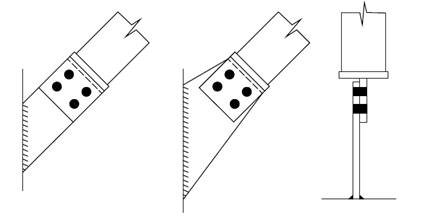Technical
AD 386: Clarification of notch dimensions and shear resistances in SCI P358 (Green Book on Simple Joints)
On page T-4 of SCI P358[1], Table G.1 Note 4 states that for double notched beams, the remaining depth of web is taken as the end plate length. This is misleading and provides no information on single notched beams. This AD explains what notch dimensions were assumed and how the quoted shear resistances were calculated for single and double notched beams.
Notch dimensions
For single notched beams, the notch depth was taken as the larger of 50 mm or the clearance n as given in SCI P363[2] (Blue Book). For most beams therefore, the notch aligns with the top of the end plate, set 50 mm below the top of the beam. For large beams, where the thickness of the flange plus root is greater than 50 mm, it is assumed that the end plate is lowered to clear the root, and the notch depth is correspondingly increased.
For doubly notched beams, the upper notch follows the rules given above for single notches. The lower notch similarly follows these rules for large and medium sized beams. For 406 × 140 and smaller, the lower notch depth is simply taken as 25 mm. The rules are given in the figure below.
Calculation of shear resistance
When compiling the resistance tables (Tables G.4 & G.5), the first step was to determine the maximum notch length which could accommodate the shear resistance quoted for the beam without a notch. In many cases, the maximum notch length was zero, or some small dimension which had no practical benefit. In these cases, a reasonable notch length was set as 100 mm and the resistance back-calculated (using an iterative process) for this geometry. In this process, the applied shear was increased until the applied moment at the notch equalled the moment resistance. An iterative process was required as the moment resistance is reduced in the presence of high shear; the reduction varies with the applied shear.
In the resistance tables, if the maximum length is quoted as 100 mm, it will be associated with a reduced shear resistance, indicating that the process above has been followed. For lengths longer than 100 mm, the resistance will be that for an un-notched beam. Occasionally for double notched beams, where ‘N/A’ is shown in the shear resistance column, it indicates that after the notches have been removed (following the guidance given above) the remaining depth of web is less than the depth of the end plate. In these cases the resistance of a non-standard connection will have to be determined by calculation.
In many cases, the dimensions of the supporting beam may dictate the size of the notch. In these cases the resistance will have to be determined by calculation.
References:
[1] SCI P358 Joints in Steel Construction: Simple Joints to Eurocode 3. (2014)
[2] SCI P363 Steel Building Design: Design Data. (Updated 2013).
Contact: David Brown
Tel: 01344 636525
Email: advisory@steel-sci.com












